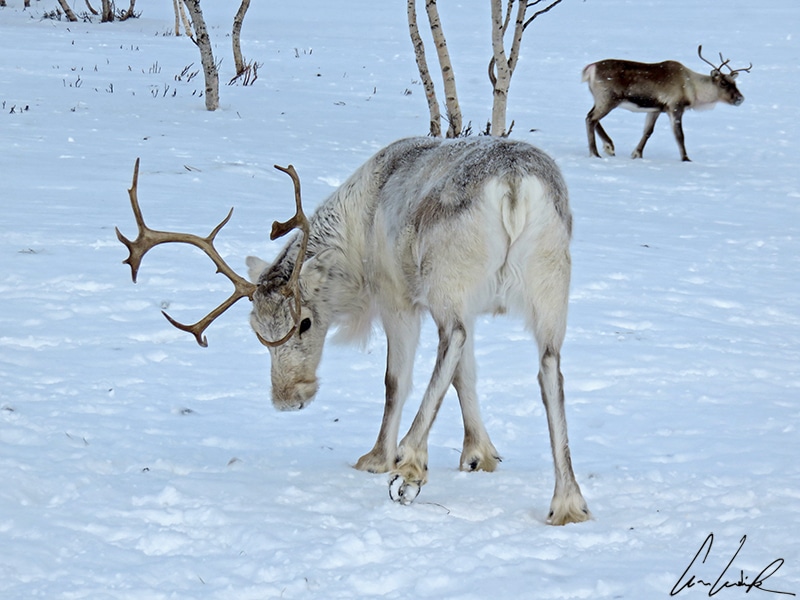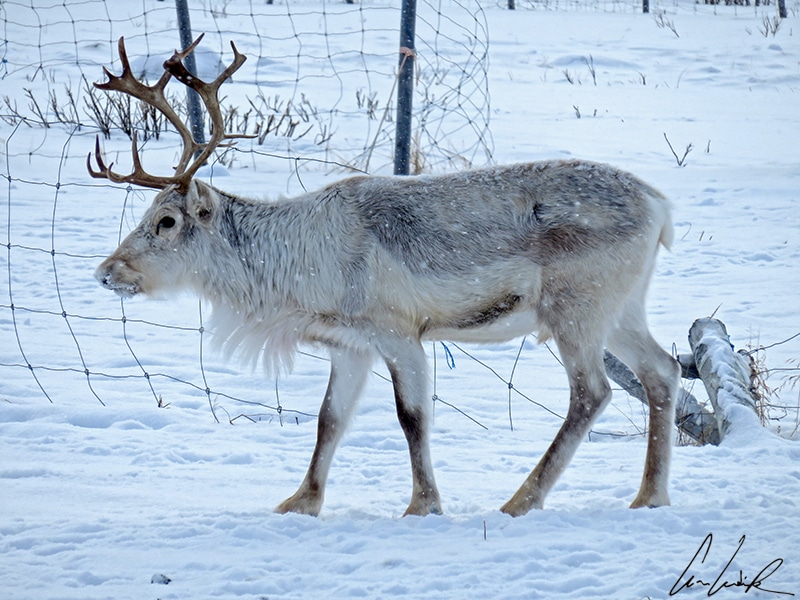The reindeer, often called Rudolph after Santa Claus’ animal, is undoubtedly the symbol of Lapland. For tourists, reindeer and Lapland are inseparable! Reindeer live in the Far North and feed on lichens, bark, moss, and the branches of shrubs… But it is essential to know that in Lapland, most reindeer are part of a herd. The Sámi, “the last and only indigenous people of Europe,” are the reindeer herders of the Far North. During a stay in Lapland, you can observe reindeer in the wild (but in the wild, they are fearful) or opt to visit a reindeer farm.
The reindeer, the king of animals in Lapland
The reindeer (Rangifer tarandus) is the postcard of Lapland… Around the world, reindeer are associated with Santa Claus. According to legend, Santa’s sleigh is pulled by nine flying reindeer named Dasher, Dancer, Prancer, Vixen, Comet, Cupid, Donner, Blitzen, and Rudolph the red-nosed reindeer. The color of the fur of these short-tailed deer varies from grey to brown. The male or the bulls can weigh up to 400 pounds for a shoulder height between 33 and 59 inches. Females or cows are smaller, weigh between 180 and 260 pounds, and have a shoulder height of 51 inches. The reindeer is the only member of the Cervidae family in which both males and females grow antlers. They shed their antlers in winter or spring each year, growing a new pair the following summer. The antlers of adult males are formidable weapons against predators (wolves, brown bears, lynx or the wolverine, heroes of Marvel movies). Male reindeer use their antlers to compete with other males during the mating season, which takes place at the end of the summer. Fight or walk away ? The line “It’s easier to walk away than fight for what you really want” from the TV show “Pretty Little Liars” could also apply to reindeer. The reindeer is an endurance runner. They can travel at 20 mph for an extended period, but they can sprint at speeds up to 48 mph if in danger.

The reindeer is the iconic animal of Lapland
Reindeer have adapted to the cold and darkness of the winter months. They are well-suited to extreme cold and poor environments. Their coat has two layers of fur. The longer-haired overcoat consists of hollow air-filled hairs. This coat helps insulate the reindeer from the cold. Fur is the primary insulation to maintain body temperature. Reindeers have slender legs with large feet with crescent-shaped hooves for walking more easily in the snow or the mud of the spring. Their hooves are adapted to the season. In summer, the footpads are sponge-like, and in winter, the pads shrink and tighten, exposing the rim of the hoof, enabling them to scrape, cut, and dig down through the snow to access their food (grasses, lichens, bark, moss, mushrooms, and shrub branches.) The size of the reindeer herds puts pressure on slow-growing plants and lichen, forcing the animal to move regularly and migrate for food.

Reindeer with slender legs and large hooves
The Sámi and reindeer husbandry
Reindeer are a central part of the Sámi way of life, the legacy of a history that goes back more than ten thousand years and is passed down from generation to generation. There was a time when herders traveled on cross-country skis to follow the reindeer on their migratory routes. The Sámi people lived mainly from fishing and gathering, and the reindeer provided them with everything they needed for food, clothing, and shelter. Today, animal husbandry is still part of the Sámi culture, even if most of the Sámi can no longer live from it. With climatic disruption, the alternating periods of frost and thaw leave the lichen imprisoned under hard ice. The reindeer have difficulty finding food on their own, and it is becoming more and more expensive for the herders to buy food. The Sámi often have parallel activities to reindeer husbandry, which are related to their culture and traditions: handicraft, art, or tourism. Tourism around the reindeer is quite important and allows the herders to have a complementary source of income. All travelers want to see reindeer, and reindeer farms enable easy interaction with this iconic animal.
Visiting a reindeer farm in Lapland
Visiting a reindeer farm is an opportunity to spend a day with the most emblematic animals of Lapland and their Sámi herders, who will tell you about their way of life and contact with nature. Many farms welcome the public: you will meet the reindeer and have the opportunity to feed them and take pictures of them. Be careful; reindeer are greedy! They are not shy but seek food more than human contact. If you want to continue the adventure, you can opt for a reindeer sleigh ride. This ride will delight young and old alike. Aboard a sleigh, you will lead your team exactly as Santa would! It takes about 3 years for a reindeer to learn to pull a sled. It’s a lot of work to teach them because it’s not a skill a reindeer is born with. Sled rides are done at moderate speed and can last from a few minutes to a few hours. These rides are therefore accessible to all passengers, including young children.

Reindeer farm in Lapland
Seeing reindeer in the wild in Lapland
Reindeers live semi-wild in Lapland. They roam freely, so you can see them just about anywhere. They move around depending on the time of year and seem never to be in the same place. Remember that the reindeer is a rather shy animal, even if it is used to humans. If you want to see them, it is better not to make too much noise in the wild. In winter, they are often found on the side of the road (they are the main road hazard, by the way), so keep your eyes open. Reindeer warning signs are posted along the roads because a herd of reindeer may decide to cross in front of your car at any time. After all, it is their right of way…

Reindeer on the roadside in Lapland

